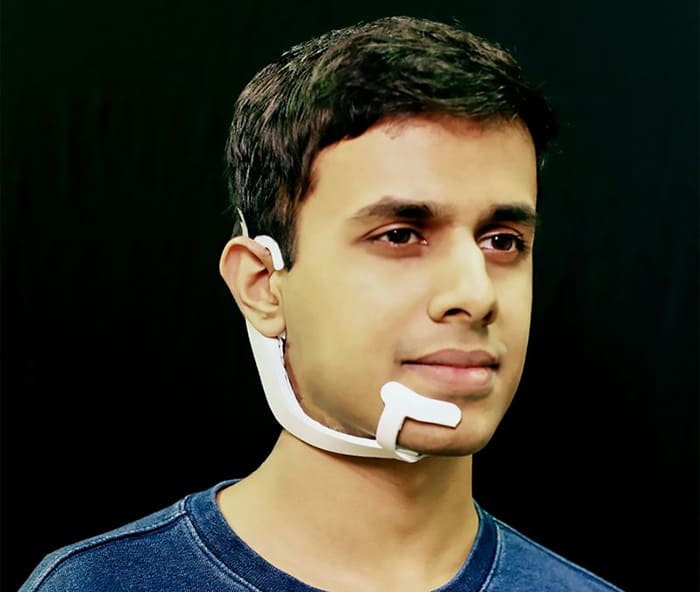
If my friend Nishant asks me to search for a specific piece of information, and that is even without speaking, whispering, typing, writing, or without any type of body movements. Then, how do I find it? Ever think about it? But, this can be possible now through the newly invented MIT Media Lab’s AI-headset AlterEgo, which can transcribe words a person says in his head. Let’s explore the outstanding idea in-depth.
Do You Know?
MIT Media Lab’s AlterEgo is one of Time’s Best Inventions of 2020.
What does AlterEgo Mean?
AlterEgo – an Artificial Intelligence-enabled headset –
- is a non-invasive, wearable, peripheral neural interface that doesn’t read your thoughts, but it can help you to communicate with your computer without touching a keyboard or opening your mouth.
- uses a bone conduction speaker that only you can hear.
In simple words, the headset is a silent speech system that can read internal speech vibrations & can translate your silent thoughts into speech. It will be helpful for those people who cannot speak out loud due to illness or injury.

How does AlterEgo read words you say in your head?

AlterEgo is consists of a wearable device and an associated computing system. Electrodes in the device pick up neuromuscular signals in the jaw and face that are triggered by internal verbalizations — saying words “in your head”.
These signals are undetectable to the human eye but the machine-learning system that has been trained to correlate particular signals with particular words will transcribe it.
Bone-conduction Speakers
The AI-enabled headset also includes a pair of bone-conduction headphones, which transmit sound via vibrations through the bones of the face to the inner ear. As these headphones not obstruct the ear canal, hence the user is able to carry on a normal conversation and hear a surrounding sound.
So, these headphones enable the AlterEgo to convey information to the user without interrupting conversation or otherwise interfering with the user’s auditory experience.
Thus, the device is part of a complete silent-computing system that lets the user undetectably pose and receive answers to difficult computational problems
Kapur says:
You can connect the device via WiFi to a smartphone, and silently dictate text messages or commands to smart-home assistants. Or you could ask AlterEgo to solve math problems for you or act as an in-head translator for foreign languages.
Can this device read my mind?
No, this device cannot read your mind.
| Features | Description |
|---|---|
| How signals read by device? | It only reads those words or signals which are silently spoken from your facial and vocal cord muscles. |
| Have any direct & physical access to my brain activity? | No. The device can’t read your thoughts. |
| Silent Speaking | Say a word without actually voicing it. |
It allows people to chat in natural language with machines, Artificial Intelligence (AI) assistants, services, and other people without any voice & without opening their mouth – simply just by articulating words internally.
How AlterEgo Works?
According to Time Magazine, the wearer of AlterEgo has to first formulate the question in their mind to use the headset to carry out a simple task like Googling the weather on your laptop.
The sensors embedded in the headset read the signals that formulation sends from your brain to areas you’d trigger if you had said the query aloud, like the back of your tongue and palate.
The headset via a web connection carries out the task on your laptop. It uses a bone conduction speaker to inform the wearer of the results of the task that only the wearer can hear.
Note: MIT Researchers found that the device’s prototype was able to understand its wearer 92% of the time. The interface is currently being tested in limited hospital settings, where it helps patients with multiple sclerosis and ALS to communicate.
The current system is a research prototype only and will require significantly more research and development before it could be deployed in real-life settings
Examples: AlterEgo in Laymen Language
Example One: Books are my best friends & while reading them I have to depend on the external sources if I stuck on any particular word. But, what if I get answers without looking at explicit sources then? It will be marvelous. Through the newly invented Artificial Intelligence (AI) technology – AlterEgo – it can be possible.
Example Two: When my friend asked the meaning of a particular word in public that I don’t know, then I can silently ask the device for a definition, so as to cope better in an awkward situation.
The Artificial Intelligence (AI) in AlterEgo will then figure out the answer and feed it back to me – through the bone-conduction speaker, through the device. I can hear that answer in my head but is inaudible to an observer. This will happen in real-time.
Facts: AlterEgo
If someone has a desire to integrate human & machine intelligence right inside his or her body then AlterEgo is one of the best examples in today’s AI world that boost human insight and give a silent speech to those who have lost their ability to speak.
| Facts | Description |
|---|---|
| History | Invented by a team of researchers at the Massachusetts Institute of Technology’s (MIT) Media Lab. Lead by Delhi-born scientist Arnav Kapur. |
| Task | Enable users to silently communicate with a computer device using their thoughts. |
| Helpful for whom? | Possibly helpful for people with speech impairments such as Apraxia, Cluttering, and other voice disorders. And, for those who are facing conditions such as ALS, or Lou Gehrig’s disease, stroke, and oral cancer. |
| Wearable Device | Attached around the head, neck, and jawline. |
| Translate | Translates your brain speech center impulse input into words on a computer, without vocalization. |
Note: The device does not record or read your thoughts. It records deliberate information that you want to communicate through the deliberate engagement of your internal speech systems.
Nervous System & Artificial Intelligence (AI): AlterEgo

Before proceeding further, we must have to know how our brain works & how it sends signals to our body?
The human brain is the Big Boss of creativity. It sends electrical as well as chemical signals through a network of nerves called “the nervous system” to control all the activities in the body i.e. beyond our imagination.
The nervous system is like a network of wires that relays messages back and forth from the brain to different parts of the body. It does this via the spinal cord, which runs from the brain down through the back, like the branches of a tree.
Hence, the brain then controls our sensations & muscles, so that we can walk, talk, feel, run, and move around. After reading about the human brain, I am sure, you can easily figure out how Artificial Intelligence (AI) works in AlterEgo.
AI technology in AlterEgo
Through powerful sensors, the AI technology in AlterEgo is able to detect the signals the brain sends to internal speech mechanisms, like the tongue or larynx, when you speak to yourself.
AlterEgo picks up on the internal vibrations and transmits them to an AI embedded in the device, which translates them into language.
It helps to improve:
- people’s memories,
- act as a translator,
- or allow people to access forms of expertise and Artificial Intelligence (AI) in times of emergency without needing a separate external device.
There are millions of people around the world who struggle with using natural speech. For them, communicating is a painstakingly slow and tiring process. Hence, this technology will be boon for them.
AlterEgo: Inside-Outside
| 1 | The device has sensors, embedded in a thin plastic, flexible and transparent device that sits on your neck just like a sticker. |
| 2 | These sensors pick up on these internal signals sourced deep within the mouth cavity, right from the surface of the skin. |
| 3 | An AI program running in the background then tries to figure out what the user’s trying to say. |
| 4 | It then feeds back an answer to the user by means of bone conduction, audio conducted through the skull into the user’s inner ear, that the user hears, overlaid on top of the user’s natural hearing of the environment, without blocking it. |
| 5 | The combination of all these parts, the input, the output, and the AI, gives a net subjective experience of an interface inside your head that you could talk to in likeness to talking to yourself. |
Who is Arnav Kapur?
He is an Indian scientist of the Fluid Interfaces group at MIT Media Lab with a particular focus on:
- Machine Intelligence,
- Cognition Augmentation,
- and Human-Machine Collaboration.
Goal: To try to understand why things are the way they are, and to thereby bring about positive mutations through engineering solutions.
To get all the latest tech news, like us on facebook and follow us on twitter, instagram & LinkedIn. |






